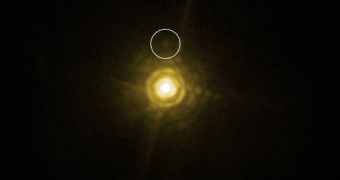In a series of recent observations, astronomers were able to observe the direct light emanating from an exoplanet. The celestial body is in orbit around its parent star, called HR 8799, about 130 light-years away from our planet. The young, Sun-like star has until now revealed three companions, all of which are very large exoplanets, from the gas giant class. They are between seven and ten times the mass of Jupiter, and all four bodies together resemble a hugely scaled-up version of our solar system. The planet orbiting HR 8799 in the second orbit, between the two other gas giants, was recently imaged directly by a new telescope survey.
The three exoplanets were discovered in 2008, as astronomers were investigating the star using the European Southern Observatory's (ESO) Very Large Telescope (VLT), in Chile. The group behind the finds noticed that each of the three bodies revolved around HR 8799 at a distance between 20 and 70 times that which separates Earth from the Sun. In other words, none of them is too close to the bright, young star that is undoubtedly fairly hot. In addition to the planets, the star system also features two asteroid belts, similar to the Inner Asteroid Belt and the Kuiper Belt around the Sun. Overall, HR 8799 is 1.5 times heavier than our star, Space reports.
In the new study, rather than looking for signs of a passing celestial body eclipsing some of the light coming in from the parent star, astronomers used the massive power of the VLT to tease out the light reflecting from the middle exoplanet directly. The effort was made more difficult by the fact that HR 8799 is several thousand times brighter than the target of the new observation effort. “After more than five hours of exposure time, we were able to tease out the planet's spectrum from the host star's much brighter light,” explains scientist Carolina Bergfors, a member of the team that conducted the investigations.
“It's like trying to see what a candle is made of, by observing it from a distance of two kilometers [1.2 miles] when it's next to a blindingly bright 300 Watt lamp,” adds University of Toronto team member Markus Janson. “This will surely shed new light on the processes that lead to the formation of planetary systems like our own,” the expert adds. Details of the new investigation appear in the latest issue of the respected Astrophysical Journal. From the collected data, the experts inferred that the atmosphere of the exoplanet in question is very peculiar, and that discovering its chemical make-up would require a lot more study.

 14 DAY TRIAL //
14 DAY TRIAL //